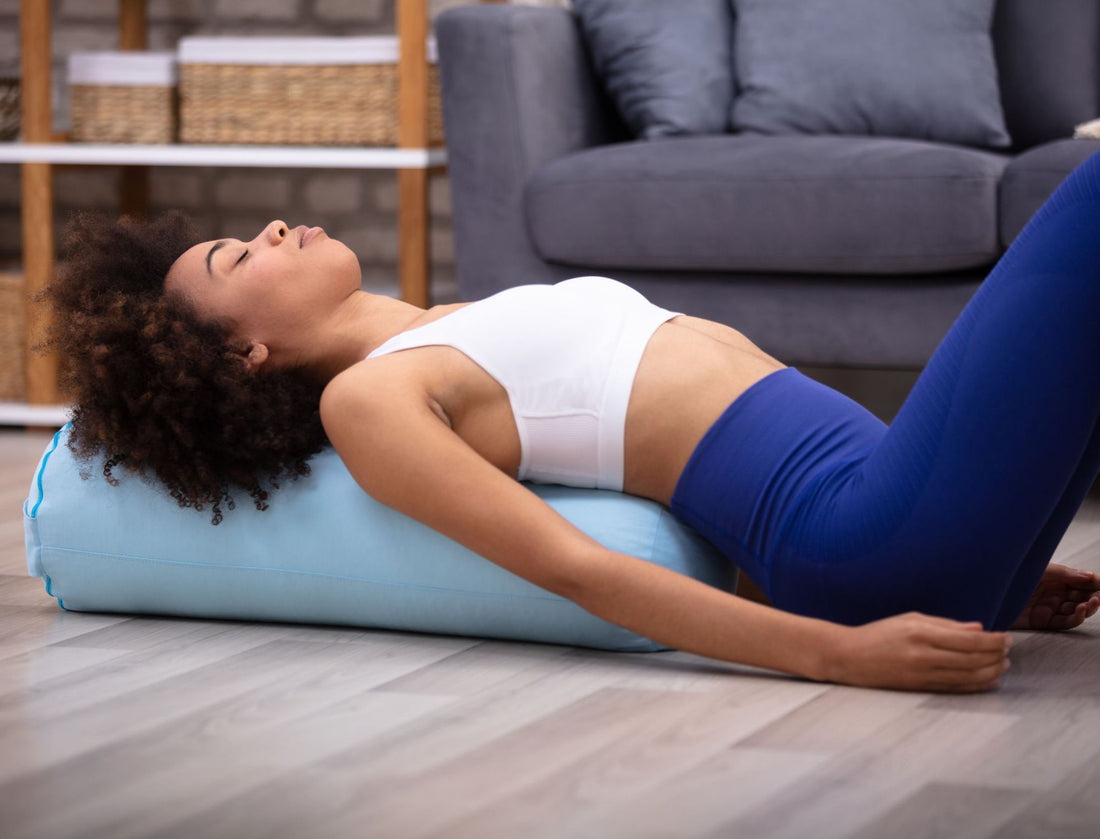
Guide to Gentle Yoga: Posture, Poses & Benefits
Share
What is Gentle Yoga?
Are you new to yoga or looking for ways to move your body without hurting it? Gentle yoga is great for people of all ages and abilities. Still, it can be helpful for specific people, particularly those with injuries, mobility issues, or other health issues that may prevent them from doing higher-impact exercises.
In this article, you’ll learn the differences between gentle, hatha, and restorative yoga. We’ll also touch on how to practice gentle yoga, what to wear, and how to get into some gentle yoga postures.
Should Beginners Start With Gentle Yoga?
New yogis can start at whatever feels best for them. If you already exercise semi-regularly, you’ll likely be fine in a faster-paced vinyasa class. Even if you don’t exercise regularly, you can adapt or modify postures to meet you where you are.
But if you want to ease into the yoga experience, however, or you’re recovering from an injury, you might enjoy the slower-paced practice of gentle yoga. You won’t lay on the ground in a burrito for the whole class (that’s restorative), but you likely won’t get your heart rate up.
Beginners will find a safe, welcoming, gentle experience in a gentle yoga class.

Gentle Yoga vs. Restorative Yoga vs. Hatha Yoga
It’s easy to feel confused when learning about all the different types of yoga. The most commonly mixed-up types are gentle yoga vs. restorative yoga vs. Hatha yoga. While they may not be the same, they’re each wonderful in their own way. Let’s take a look at what makes each of these practices unique.
Gentle yoga focuses on slow, thoughtful movements. You might still do forward bends, very gentle backbends, and other types of stretching, but the focus will be on accessibility, modifications for those who need them and keeping the body safe. A gentle yoga pose likely won’t be an advanced shape many struggle to hold.
Restorative yoga is similar to yin yoga, except yin has you stay in “active” poses for longer durations, and restorative yoga aims for you to relax into whatever posture you’re taking. To achieve a restful or non-active yoga shape, you’ll likely use a lot of props. Bolsters and blankets are your friends in these classes.
Hatha yoga is still slower than a vinyasa class but can still be physically demanding. Hatha dates back centuries but didn’t become popular in the U.S. until more recently. The focus of Hatha is to channel the “vital life force” within our bodies through breath, posture, and meditation. You likely won’t find a “flow” where you’re moving. Instead, you’ll settle into each posture to notice your experience.
While each of these practices are more gentle, they each provide a unique experience.
Types of Gentle Yoga Flows
Do you want to explore the full range of gentle yoga offerings available? You might be surprised to find that many of these will leave you just as sore as a power class but in a different way. Of course, many of them won’t push you that hard, like Yoga Nidra and restorative yoga. But many force you to slow down your movements, or hold supported and unsupported yoga poses longer, so you really get into the meat and muscle of your body.
Keep reading to learn about a few different types of gentle yoga practices. When researching a class, always check the description to know what to expect. A class labeled “gentle yoga” may be slow, gentle movements where you stay in a relaxed physical state, while others, like some hatha, yin, and some types of kundalini.

-
Hatha Yoga
Hatha Yoga has been documented in Buddhist and Hindu texts dating back to the 1st century. It aims to channel our life force and energy through posture, breath control, and mindfulness. As with many yoga classes, you’ll likely experience a warm-up period at the start of class, a transition into more complex shapes, and ending on some type of meditation at the end.
-
Restorative Yoga
Restorative yoga is blissful for the fast, always-on-the-go person. If you struggle to relax, do it in a restorative class. You’ll often spend an hour to 90 minutes moving into a handful of yoga postures. Most of the time, these poses will be on the floor and supported with props, so you don’t have to use your muscles to hold yourself in the shape. For some, this might sound boring, but it’s such a good practice to incorporate into your week.

-
Yin Yoga
Yin yoga differs from restorative because you’re in an active shape. No, you aren’t moving through a vinyasa flow. Instead, you’re holding a shape for a longer period of time, often a few minutes, but without a prop to hold you up. Yin uses body weight to move into a shape, and as you start to relax into something, pigeon pose, for example, your muscles will relax so you can access the joints and fascia. Yin is a “cold” practice where you don’t want your muscles warm to begin with because when the muscles are warm, they start doing more of the work.
-
Chair Yoga
Chair yoga is great for beginners. It’s also perfect for those who struggle to do many of the common yoga poses without some extra support. The greatest part of yoga is that there’s no shame in where you’re at physically. If a cat-cow on your hands and knees isn’t accessible, you can do it seated in a chair and still gain flexibility and benefits without hurting your body.

-
Yoga Nidra
Yoga Nida is a really cool practice. Many people opt for hot yoga or power classes, but there’s something special about Yoga Nidra and restorative-type classes. This class aims to get you into a state of consciousness where you’re asleep yet awake. It’s an in-between place where you can still feel the ground underneath your body, but you might also dream simultaneously. Yoga Nidra has many potential health benefits for everyone.
-
Iyengar Yoga
Iyengar yoga stemmed from Hatha yoga and has many of the same personality traits. This practice focuses on alignment throughout the body and helping people safely move into different gentle yoga postures through the use of props like straps, blocks, and many items you can find around the home. Unlike some forms of yoga, Iyengar doesn’t have a strong spiritual component.

-
Sivananda Yoga
Sivananda yoga is a less popular form of yoga, although you might see these types of classes pop up during the full moon. This practice involves moving through Sun Salutations uninterrupted. You’ll likely be led through different pranayama or breathing exercises to help you focus on the flow of energy in your body. Sivananda might be considered less gentle than some of these other forms, but you likely won’t experience explosive movements unless you incorporate them yourself.
-
Kundalini Yoga
Kundalini yoga is another type of yoga that can be as gentle or intense as you want. For many, it’s an intense practice on a deeper level because Kundalini involves chanting, breath patterns, postures, and mudras (hand signals) that encourage an energy at the base of your spine to “awaken.” For many, this is an emotional experience, sometimes draining and also blissful.

Gentle Yoga Postures and Poses
Are you looking for some gentle yoga postures and poses to practice at home? You can incorporate these into the beginning and end of a workout or just to give your mind and body a reset whenever you need it. The most popular gentle yoga poses are:
-
Child’s pose —
 Child’s pose isn’t always accessible for people, but you can use blocks and bolsters to support your body. If you need extra support, you can stack up 2, 3, or 4 bolsters and lay your chest on them if the full expression of the pose is too intense on your knees.
Child’s pose isn’t always accessible for people, but you can use blocks and bolsters to support your body. If you need extra support, you can stack up 2, 3, or 4 bolsters and lay your chest on them if the full expression of the pose is too intense on your knees.
-
Supported bridge pose —
 Supported bridge pose is just as it sounds. You’ll need a block, a blanket, or a bolster. Lay on your back with your feet planted on the ground just below the glutes with your knees bent and pointing to the sky. To get into a supported bridge, lift the hips as high as is comfortable and safe for you, and then slide your prop under your sacrum.
Supported bridge pose is just as it sounds. You’ll need a block, a blanket, or a bolster. Lay on your back with your feet planted on the ground just below the glutes with your knees bent and pointing to the sky. To get into a supported bridge, lift the hips as high as is comfortable and safe for you, and then slide your prop under your sacrum.
-
Supine twist —
 Another gentle yoga pose is the supine twist or even a supported supine twist. In a Yin class, you lay on your back with your knees bent and feet on the floor. Then allow both knees to fall to one side or the other for a gentle twist to the spine. In restorative, or if you need the extra support, you can stack bolsters underneath the knees on the side they fall.
Another gentle yoga pose is the supine twist or even a supported supine twist. In a Yin class, you lay on your back with your knees bent and feet on the floor. Then allow both knees to fall to one side or the other for a gentle twist to the spine. In restorative, or if you need the extra support, you can stack bolsters underneath the knees on the side they fall.
-
Seated forward bend —
 A forward bend is another great gentle yoga pose, depending on how you access it. For some, sitting up straight with the legs extended is already a challenge. To modify this into a more accessible posture, you have many options. One option is to place a bolster under the knees and another bolster across the lap and fold over both.
A forward bend is another great gentle yoga pose, depending on how you access it. For some, sitting up straight with the legs extended is already a challenge. To modify this into a more accessible posture, you have many options. One option is to place a bolster under the knees and another bolster across the lap and fold over both.
Benefits of Gentle Yoga
The list of benefits of gentle yoga is long, and you’ll definitely want to try it out for yourself. Some of the potential benefits include the following:
-
Greater flexibility and happier joints — Imagine the body like a machine. You need to oil all those joints to keep them running smoothly rather than letting them rust.
-
A more relaxed state of mind — All forms of yoga and exercise can have this benefit because your body is releasing lots of feel-good hormones. Gentle yoga can increase this state of relaxation due to the nature of the slow and mindful practice.
- Less stress — in addition to a more relaxed and regulated body, you may notice that stress becomes less. It’s not that the stressors are gone, but rather the practice of noticing our emotional states gives them less power. So instead of swinging far out into major stress, that pendulum swing gets smaller.

What to Wear to Gentle Yoga
The best part about gentle yoga is that you can wear whatever makes you feel comfortable. You can wear a sweatshirt, yoga pants, sweatpants, leggings, a swimsuit, your birthday suit, whatever. The most important consideration for what to wear to gentle yoga is the type of class, your comfort level, and the environment.
-
HardTail Bootcut Flare Yoga Pants — These bootcut flare pants are made from soft organic cotton with a fold down waistband that can be worn up or down. A yogi favorite. Made in the USA
-
Beyond Yoga Limitless Straight Leg Pant - A relaxed yoga pant that has a straight leg and stretches easily throughout any posture. Made in the USA
-
Jala Chill Yoga Pants — These flowing yoga pants from Jala are perfect for a gentle yoga class and will keep you cozy throughout the rest of the day.
-
Free People Cropped Run Tank — Gentle yoga is all about finding comfort in your body, and this seamless crop top from Free People will do just the trick.
- Handful Chillax Crew— Be comfy on top with a relaxed pullover that has stretch and is still breathable.
Gentle yoga is a low-impact, beginner-friendly practice. The best part is that it’s accessible to anyone, and if a class is too challenging, you can modify it to fit your needs. You don’t need explosive power classes every day to build strength and flexibility. So we encourage you to incorporate at least one gentle yoga practice into your weekly movement routines. Your body and mind will thank you.

